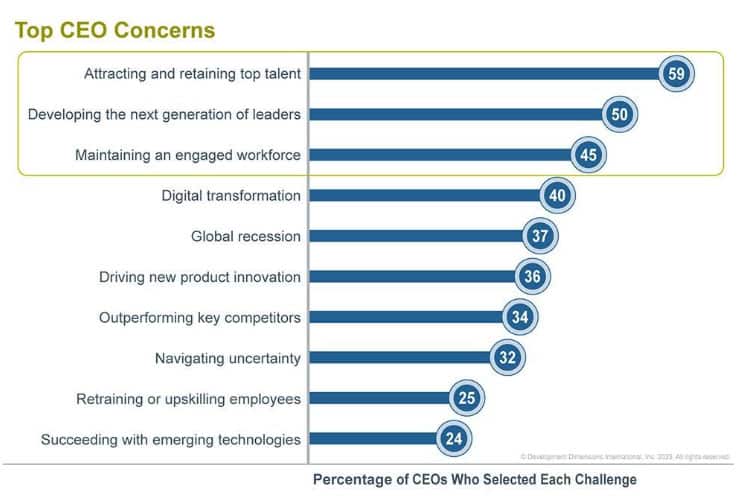The Human Factor: The Top 3 Concerns Keeping CEOs Up at Night

Amid blazing headlines about layoffs, advancements in artificial intelligence, and economic markets in turmoil, it may appear that the least of CEOs’ concerns are their people. Yet despite this volatility, the labor market remains tight: recent BLS data showed there were 1.9 job openings for every person looking for one. With employees in the driver’s seat of the job market, it’s the strength of their people that’s really keeping CEOs awake at night.
In a recent study by my organization, Global Leadership Forecast 2023, we analyzed the responses of 1,827 human resource professionals and 13,695 leaders worldwide (including 529 CEOs) about the state of leadership.
And the findings were surprising: For the first time in more than 20 years, talent challenges comprised the top three concerns for CEOs. While the challenges are related, the C-suite should look at each uniquely and address the most critical underlying factors.

CEO Concern #1: Attract and Retain Top Talent
As uncertain business and economic conditions loom ahead, CEOs are keenly aware that they will need a highly talented, well-rounded workforce that will quickly be able to pivot and solve new challenges. However, in the wake of mass resignations and tight labor markets, 54% of companies saw their turnover increase in the previous year. Most companies are struggling to fill open roles, with less negotiating power than usual to hold out for top talent.
It’s clear that the companies that prioritize attracting and retaining the most talented teams will have a clear edge in the market ahead, regardless of how business and economic conditions change.
What to do about it:
First and foremost, the C-suite needs to get serious about training leaders to practice empathy and build stronger relationships with their teams. Leaders cited having ineffective leaders as the top reason they would want to leave their company. In fact, leaders who said their company’s leaders lacked interpersonal skills were 3.5X more likely to say they intended to leave within a year.
In addition, as many CEOs and executive teams debate the merits of bringing back remote workers, consider the strong likelihood that it will drive away the most talented leaders, especially younger leaders. Among companies that did not support flexible work, our study showed that leaders were 1.3X more likely to leave, with those under 35 being 2.2X more likely to depart.
CEOs need to think carefully about how they set the tone for the leadership culture in their organization. Those who practice a holistic, human-centered approach that addresses employees’ personal and practical needs are more likely to succeed in the war for top talent.
CEO Concern #2: Develop the Next Generation of Leaders
While developing next-gen leaders should always be a priority as CEOs plan for long-term growth, it’s now bubbling up to a level of heightened concern. Younger, high-potential leaders are acutely aware of their value in the labor market, which means that companies must work harder to retain them. Our research showed that three years tends to be the critical tipping point for these young leaders as they evaluate whether they have long-term opportunities for growth at their current company.
One of the key challenges for this group is that many companies have a culture built on the expectation that leadership is synonymous with grueling working hours. However, in the post-pandemic world, high-potential workers are seriously calling into question whether they want to accept demanding work schedules at the expense of their personal life.
What to do about it:
High-potential leaders need to see a future career path with their employer. To support that, C-suite leaders should cultivate a culture of internal mobility, along with offering development programs that help these leaders feel that they are being invested in.
To ensure development programs are effective, the C-Suite needs to set clear and realistic performance expectations. Leaders want to know what it takes to succeed in their current roles, as well as understand how they can get to the next level. Furthermore, the “realistic” part is important, given fewer high-potential leaders are willing to accept “burnout culture.” C-suite leaders should think about how they reward and advance leaders who show effective leadership behaviors, such as delegation, team engagement and performance, low turnover, etc. over those who put in more hours, which may or may not lead to better results.
Lastly, effective coaching is critical: 85% of high-potential leaders want more coaching, whether from internal or external coaches, to help them develop as leaders. In particular, younger leaders crave this feedback and support to help them grow. This type of coaching culture needs to be modeled by the C-suite, both in how they coach others and how they welcome feedback and coaching from others.
CEO Concern #3: Maintain an Engaged Workforce
Rounding out the top three concerns for CEOs is the pressure they feel to maintain an engaged workforce, which leads to better performance across the board. While employee engagement isn’t new, our research showed that there are two critical factors at play right now that are driving employees’ sense of engagement.
The usual drivers of engagement are still relevant. People want to work for effective managers, be compensated fairly for their work, have opportunities for growth, etc. However, there is an often-overlooked driver of engagement: A strong sense of purpose at work. Participants in our study who said they had a strong sense of purpose were 9X more likely to feel engaged in their role, and 2.4X more likely to say they intended to stay at the company.
Creating a strong sense of purpose starts at the top of the organization, which is why it’s critical for the C-suite to pay attention to. Unfortunately, only 63% of C-suite leaders reported having a strong sense of purpose themselves. For the one-in-three C-suite executives who are struggling to find their own purpose at work, it’s unlikely they’re able to infuse purpose into the organization, which can lead to major problems.
What to do about it:
One of the big misconceptions at work is that it must be tied to a noble cause. While a noble cause, like saving lives for healthcare workers, does help, companies in any industry are able to drive a strong sense of purpose. In fact, our study showed that some of the industries excelling the most in having a purpose-driven culture are agriculture, retail, and pharma. The key is how company leaders set the tone.
The C-suite needs to set an expectation and hold leaders accountable for growing the talent on their teams. One way to do this is by encouraging managers to conduct frequent and meaningful career conversations. At the top of the house, executives need to set a clear vision for what the organization is striving to achieve, and how you will know you are seeing success. From there, lower-level managers need to help their teams see how their contributions impact overall success.
A clear vision for success also requires creating space for self-reflection. Many C-suite leaders make the mistake of focusing only on driving priorities forward, without allowing time for leaders to self-reflect on how they find personal growth through their work. Additionally, C-Suite leaders shouldn’t take having the right tools for granted. Leaders who said they had the tools to do their jobs well were 5X more likely to find their jobs full of meaning and purpose. So, executives should be intentional about the tools in place, from having the appropriate talent on their teams to the technology they use to the training leaders receive.
There’s no question that other business concerns will temporarily take up the C-suite and board’s mindshare as they grapple with rapidly changing conditions. However, it’s clear that having the right talent and leadership culture in place is the single most important factor to prepare for and reduce risk in facing those challenges. If your C-suite is not paying attention to these things now, they should be – or risk their long-term success.
Written by Stephanie Neal.
Have you read?
Interview with Michael Given, Head of Sales at Hopp.
More CMOs Being Called to Power Growth, Drive Near-Sales by Pete Hayes.
Are You a Good Fit for a CEO Forum by Leo Bottary.
4 Ways CISOs Can Prove Their Worth to Other C-suite Members by Rhett Power.
New Study Shows Managers are Changing Their Minds About the Hybrid Work Model by Dr. Gleb Tsipursky.
Bring the best of the CEOWORLD magazine's global journalism to audiences in the United States and around the world. - Add CEOWORLD magazine to your Google News feed.
Follow CEOWORLD magazine headlines on: Google News, LinkedIn, Twitter, and Facebook.
Copyright 2025 The CEOWORLD magazine. All rights reserved. This material (and any extract from it) must not be copied, redistributed or placed on any website, without CEOWORLD magazine' prior written consent. For media queries, please contact: info@ceoworld.biz








